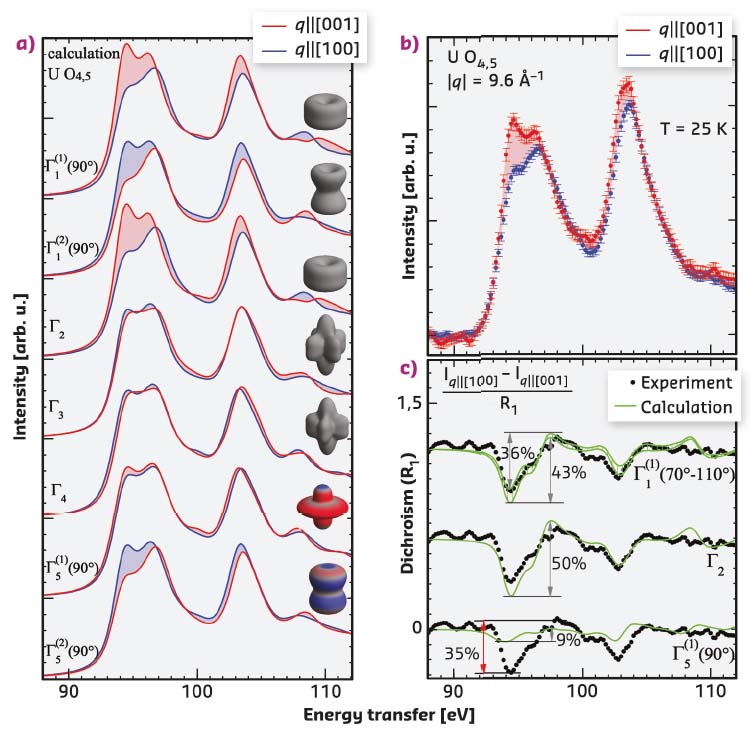- Home
- Users & Science
- Scientific Documentation
- ESRF Highlights
- ESRF Highlights 2017
- Electronic structure, magnetism and dynamics
- Hidden order and 5f electron charge density in URu2Si2
Hidden order and 5f electron charge density in URu2Si2
The symmetry of the crystal field ground state of the hidden order compound URu2Si2 was determined with a non-resonant inelastic X-ray scattering experiment at ID20. The strong anisotropy of the scattering signal was modelled with a full multiplet code and a quantitative result for the ground state wave function was obtained.
Thirty years ago, specific heat (entropy) measurements indicated that URu2Si2 undergoes a phase transition at 17 K into an electronically ordered state. Since then, this order has been investigated by many experimental and theoretical physicists worldwide but, nevertheless, both the type of order and the reason for this order have yet to be discovered. This quantum phenomenon is therefore called hidden order [1-4].
Solving the hidden order puzzle is not only an intellectual challenge; it also advances theoretical concepts that are relevant for the design of new materials with exotic properties that may find applications in daily life. URu2Si2 is therefore a model material for solid state physicists in a sense that new theories and new experiments are continuously being developed to solve the hidden order.
It is generally accepted that the distribution of the electronic density of the uranium atoms at low temperatures is an important key to understand the hidden order. In the present work, the aim was to investigate the 5f electron density of U in URu2Si2. The tetragonal point symmetry of U in URu2Si2 splits the U 5f2 Hund’s rule ground state into five singlets and two doublets (insets of Figure 88a).
 |
|
Fig. 88: a-b) Scattering function as obtained in a NIXS experiment at the U O4,5 edge for |q| = 9.6 Å-1. a) Simulation (Quanty) of the direction dependence of the 5d104f2 → 5d94f3 transition for the seven crystal-field states. b) NIXS data for the two directions of momentum transfer. c) Comparison of difference spectra (dichroism) with calculations of Γ1 Γ2 and Γ5. |
A non-resonant inelastic X-ray scattering experiment (NIXS), performed at beamline ID20, revealed which of the seven states is the ground state. The experiment was performed at low temperature so that only the ground state was occupied. The photon-in photon-out scattering process excites a core electron to the valence band (5d → 5f). A crucial condition for such an experiment is a high incident energy (≈ 10 keV) so that large momentum transfers can be reached (≈ 10 Å–1). The scattering signal at such high momentum transfers is dominated by higher multipole scattering terms, making the spectra excitonic and thus local. Moreover, the anisotropy of the 5f electron distribution (see insets in Figure 88a) will be reflected in a strong angular dependence; and this is what was indeed observed (see Figure 88b). The calculation of the multipole selection rules with the full multiplet code Quanty [5] gave access to the respective ground state (see Figure 88a). The singlets with symmetry Γ1 or Γ2 reproduce the observed direction dependence (see dichroism in Figure 88c). Hence either of these states or both nearly degenerate are the crystal-field ground state.
These experimental results limit the number of hidden order scenarios and are therefore an important touchstone for theoretical models.
Principal publication and authors
Direct bulk sensitive probe of 5f symmetry in URu2Si2, M. Sundermann (a,b), M.W. Haverkort (b,c), S. Agrestini (b), A. Al-Zein (d,e), M. Moretti Sala (d), Y. Huang (f), M. Golden (f), A. de Visser (f), P. Thalmeier (b), L. Hao Tjeng (b) and A. Severing (a), PNAS 113, 13989-13994 (2016); doi: 10.1073/pnas.1612791113.
(a) Institute of Physics II, University of Cologne (Germany)
(b) Max-Planck Institute for Chemical Physics of Solids, Dresden (Germany)
(c) Institute for Theoretical Physics, Heidelberg University (Germany)
(d) ESRF
(e) present address: Physics Department, Faculty of Science, Beirut Arab University (Lebanon)
(f) Van der Waals-Zeeman Institute, University of Amsterdam (The Netherlands)
References
[1] P. Oppeneer et al., Phys. Rev. B 82, 205103 (2010).
[2] J. Mydosh and P. Oppeneer, Rev. Mod. Phys. 83, 1301 (2011).
[3] P. Chandra et al., Nature 493, 621 (2013).
[4] H.H. Kung et al., Science 347, 1339 (2015).
[5] M.W. Haverkort, Phys. Rev. B 85, 165113 (2012).



